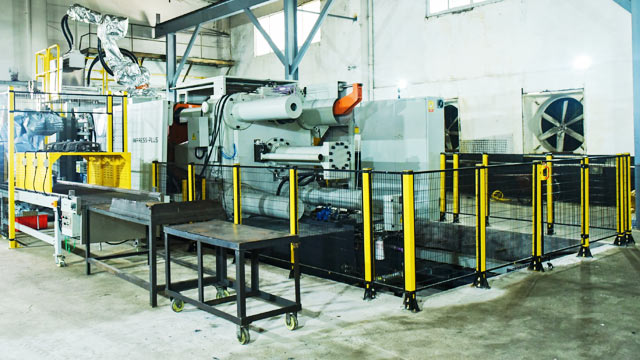
Tel : +86 15876452106
Email : fts-sales@fulfilfts.com.cn
Address : Huatai Science and Technology Park, Xiegang Town, Dongguan City
The main causes of die casting mold failure are as follows:
First, fracture failure: under the action of the compression injection force, the mold will sprout cracks in the weakest place, especially mold molding surface scribing traces or traces of electrical machining has not been grinding light, or molding of the clear corner of the first micro-cracks, when the existence of brittle phase grain boundaries or coarse grains, that is, easy to fracture. And brittle fracture when the crack expansion is very fast, which is a very dangerous factor for the failure of the mold fracture. For this reason, on the one hand, where the mold surface scratches, electrical traces and so on must be played grinding light, even if it is in the casting system parts, must also be played light. In addition, the requirements of the mold material used in high strength, good plasticity, impact toughness and fracture toughness are good.

Second, thermal fatigue cracking damage failure: die casting production, mold repeatedly subjected to radical cold and heat, molding surface and its internal deformation, mutual involvement and repeated cycles of thermal stress, resulting in two damage to the organizational structure and the loss of toughness, triggering the emergence of micro-cracks, and continue to expand, Zhongshan Hua's Fushun Special Steel said that once the cracks expand, there is a molten metal liquid squeezed, coupled with the repeated mechanical stresses are making the Crack accelerated expansion. For this reason, on the one hand, die casting start mold must be fully preheated. In addition, in the die casting production process mold must be maintained in a certain working temperature range, so as to avoid early cracking failure. At the same time, to ensure that the mold before production and manufacturing in the internal cause does not occur. Because the actual production, most of the mold failure is thermal fatigue cracking failure.
Third, dissolving corrosion failure: commonly used die-casting mold has zinc alloy, aluminum alloy, magnesium alloy and copper alloy, also has pure aluminum die-casting, Zn, Al, Mg is more active metal elements, they have a good affinity with the mold material, especially Al easy to bite the mold. When the mold hardness is higher, the corrosion resistance is better, and molding surface if there is a soft spot, it is not conducive to corrosion resistance.
Mold if the early failure, it is necessary to find out which internal or external causes, in order to improve the future.
① Mold thermal fatigue cracking failure. Die casting production, the mold repeatedly by the role of radical cold and heat, molding surface and its internal deformation, mutual involvement and repeated cycles of thermal stress, resulting in the organization structure of two damage and loss of toughness, triggered by the emergence of micro-cracks, and continue to expand, once the cracks expand, there is a molten metal liquid extrusion, coupled with repeated mechanical stresses are to make cracks to accelerate the extension of the cracks. For this reason, on the one hand, die casting start mold must be fully preheated. In addition, in the die casting production process mold must be maintained in a certain working temperature range, so as to avoid early cracking failure. At the same time, to ensure that the mold before production and manufacturing in the internal cause does not occur. Because the actual production, most of the mold failure is thermal fatigue cracking failure.
② Cracking failure. Under the action of the compression injection force, the mold will sprout cracks in the weakest point, especially the mold molding surface scribing traces or traces of electrical machining has not been grinding, or molding of the clear corner of the first micro-cracks, when the grain boundaries of the existence of brittle phases or coarse grains, that is, it is easy to fracture. And brittle fracture when the crack expansion is very fast, which is a very dangerous factor for the failure of the mold fracture. For this reason, on the one hand, where the mold surface scratches, electrical traces and so on must play grinding light, even if it is in the pouring system parts, must also play light. In addition, the requirements of the mold material used in the high strength, good plasticity, impact toughness and fracture toughness are good.
③ melt failure As mentioned before, the commonly used die-casting alloys are zinc alloy, aluminum alloy, magnesium alloy and copper alloy, there are also pure aluminum die-casting, Zn, Al, Mg is more active metal elements, they have a better affinity with the mold material, especially Al easy to bite the mold. When the mold hardness is higher, the corrosion resistance is better, and molding surface if there is a soft spot, it is not conducive to corrosion resistance. However, in actual production, corrosion is only a local place of the mold, the example of the inner gate directly flushed parts (core, cavity) prone to corrosion phenomenon, as well as the hardness of the soft place prone to aluminum alloy sticking to the mold.
 Fulfil Acme Technology Co., LTD
Quality First, Brand Awareness,Quality for Credit,
Fulfil Acme Technology Co., LTD
Quality First, Brand Awareness,Quality for Credit,Home Service Products Industries Company Resources Contact us
Mold Design Precision die-casting Stamping process CNC machining Polishing Painting Product Assembly Air Leaking Test
Display Telcom Device Aviation Nautical Vehicle Parts Medical equipment
Company introduction Factory Pictures Employee Style Enterprise Certificate Partner